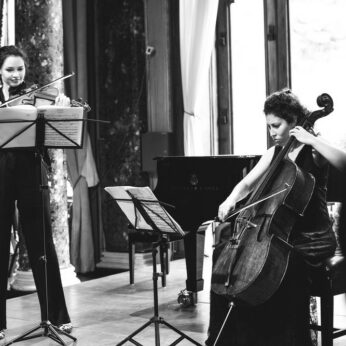Composer: Zoltán Kodály (b. 1882 - d. 1967)
Performance date: 03/07/2022
Venue: Bantry House
Composition Year: 1914
Duration: 00:29:16
Recording Engineer: Eduardo Prado, Ergodos
Instrumentation: vn, vc
Instrumentation Category:Duo
Artists:
Mairead Hickey -
[violin]
Ella van Poucke -
[cello]

Mairéad Hickey [violin], Ella van Poucke [cello]
Zoltán Kodály [1882-1967]
Duo for violin and cello Op.7 [1914]
1. Allegro serioso, non troppo
2. Adagio
3. Maestoso e largamente, ma non troppo lento – Presto
Zoltán Kodály was on holiday in the Alps in July 1914 and, on the outbreak of war, was forcibly evacuated as all the hotels were closing down. In the resulting confusion he was stuck for several days at Feldkirch on the Austrian border, where he wrote the first movement of his Duo Sonata in a school music exercise book. Everything about this gripping work is both magnificent and strange, you can hear the towering mountains and the advent of War closing in as the composer rides roughshod over all established musical conventions creating fascinating challenges for both performers and audience.
Kodály was a contemporary and fellow-student of Bartók and shared his obsession with Hungarian folk music. They both toured the countryside studying, transcribing and recording hundreds of folksongs and, in their different ways, they both incorporated their resulting sense of the nation’s musical speech into their writing. Kodály later founded the Institute of Folk Music Research of the Hungarian Academy of Science, which now has categorised records of over 100,000 folksongs of the people of Hungary and of surrounding and related countries.
Not surprisingly, Kodály’s compositional output is dominated by around 150 works for unaccompanied chorus, but his fascination with the intonation and rhythms of language translated into a small but remarkable body of instrumental writing which displays a preoccupation with enabling instruments not only to sing his ideas but to speak them in an eloquent kind of recitative.
The first movement finds us caught up in a vibrant dialogue in which the two voices alternately accompany and comment on the other’s thoughts; disagreements begin to emerge and are voiced with increasing passion until a resolution leads to a restatement of the opening material. This time we are led to the close of the movement with a quiet sense of optimism.
The singing opening of the Adagio creates an aura of eerie beauty that gives way to an impassioned central section in which the conflicts of the first movement arise again; but soon the instruments reunite and sing together through a series of varied recitatives until the opening song reappears. The movement draws to an end with a sense of wearied resignation. The last movement is full of snatches of folk-song, sometimes with bustling, vigorous accompaniment, sometimes presented with a stark simplicity. This unique work with its many moods ends with a presto, climactic flourish.
Christopher Marwood
Copyright © 2024 West Cork Music. All rights reserved.
Designed and developed by Matrix Internet